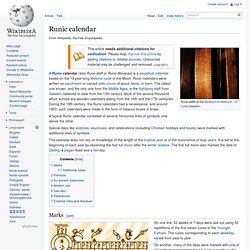

Younger Futhark. The Younger Futhark, also called Scandinavian runes, is a runic alphabet, a reduced form of the Elder Futhark, consisting of only 16 characters, in use from about the 9th century, after a "transitional period" which lasted during the 7th and 8th centuries.

The reduction, somewhat paradoxically, happened at the same time as phonetic changes led to a greater number of different phonemes in the spoken language, when Proto-Norse evolved into Old Norse. Thus, the language included distinct sounds and minimal pairs which were not separate in writing. The Younger Futhark is divided into long-branch (Danish) and short-twig (Swedish and Norwegian) runes, in the 10th century further expanded by the "Hälsinge Runes" or staveless runes. The lifetime of the Younger Futhark corresponds roughly to the Viking Age. History[edit] Germanic calendar. The Germanic calendars were the regional calendars used amongst the early Germanic peoples, prior to the adoption of the Julian calendar in the Early Middle Ages.

The Germanic peoples had names for the months which varied by region and dialect, which were later replaced with local adaptations of the Roman month names. Our records of Old English and Old High German month names date to the 8th and 9th centuries, respectively. Old Norse month names are attested from the 13th century. Like most pre-modern calendars, the reckoning used in early Germanic culture was likely lunisolar. Runic calendar. A Runic calendar (also Rune staff or Runic Almanac) is a perpetual calendar based on the 19 year long Metonic cycle of the Moon.

Runic calendars were written on parchment or carved onto staves of wood, bone, or horn. The oldest one known, and the only one from the Middle Ages, is the Nyköping staff from Sweden, believed to date from the 13th century. Most of the several thousand which survive are wooden calendars dating from the 16th and the 17th centuries.